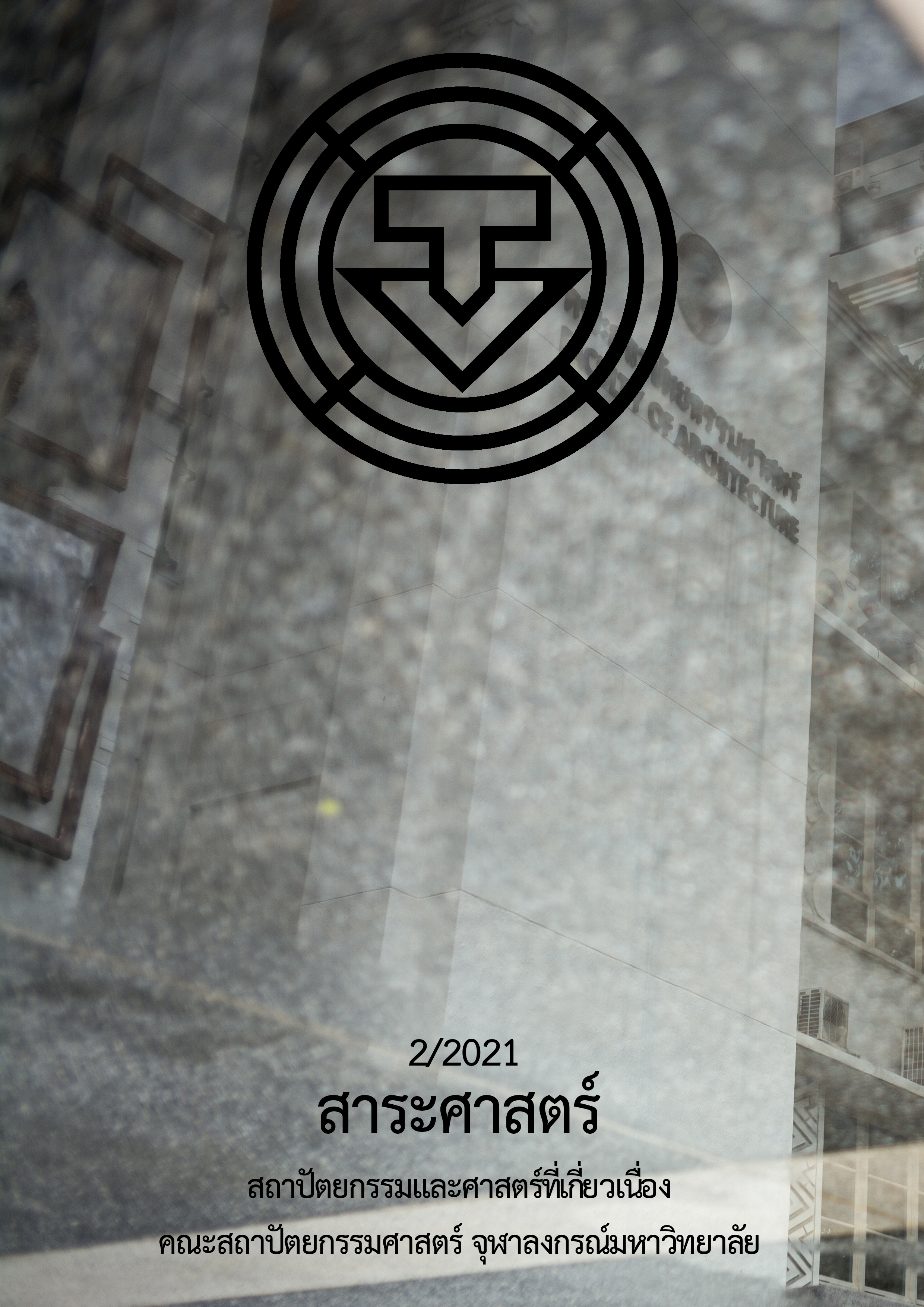การเปลี่ยนแปลงสัณฐานย่านสำเพ็ง กรณีศึกษาตรอกอิศรานุภาพ
Main Article Content
บทคัดย่อ
สำเพ็ง เป็นย่านการค้าชาวจีนนอกกำแพงเมืองที่เกิดขึ้นพร้อม ๆ กับการตั้งกรุงรัตนโกสินทร์ มีอาณาเขตตั้งแต่คลองวัดสามปลื้มถึงคลองวัดสำเพ็งหรือวัดจักรวรรดิถึงวัดปทุมคงคา ในปัจจุบันมีงานวิจัยเกี่ยวกับประวัติศาสตร์พื้นที่และถนนสำคัญในย่านอย่างถนนเยาวราชและถนนทรงวาด แต่ยังขาดความต่อเนื่องในการอธิบายกายภาพของย่านโดยเฉพาะในช่วงเริ่มต้นการตั้งถิ่นฐานชุมชนจีนในสำเพ็ง ตรอกอิศรานุภาพเป็นเส้นทางสัญจรแนวขวางกับแม่น้ำเจ้าพระยาและถนนสำเพ็ง และเคยเป็นศูนย์กลางสำคัญของย่าน จึงเลือกเป็นกรณีศึกษาเพื่อทำความเข้าใจสัณฐานและความสำคัญของตรอกอิศรานุภาพที่มีต่อย่านสำเพ็ง โดยวิเคราะห์ข้อมูลด้านประวัติศาสตร์ เศรษฐกิจ และสังคม ร่วมกับข้อมูลจากแผนที่ต่าง ๆ และการถือครองที่ดิน
จากการวิเคราะห์สามารถสรุปเกี่ยวกับตรอกอิศรานุภาพได้ดังนี้ 1) เป็นเส้นทางในแกนขวางกับแม่น้ำและถนนสำเพ็งที่มีอยู่ก่อนตั้งชุมชนและมีความสำคัญกับชุมชน 2) ตั้งอยู่บนบริบทของขนัดสวนโดยเป็นแนวคันดินระหว่างขนัดสวนที่พัฒนาเป็นตรอกทางเดิน 3) เป็นเส้นทางเชื่อมองค์ประกอบสำคัญของชุมชน ได้แก่ ท่าน้ำ ศาลเจ้า โรงเรียน ตลาด และวัด 4) ที่ดินในบริเวณนั้นมีกลุ่มที่เป็นของทรัพย์สินพระมหากษัตริย์และชาวจีนที่สำคัญในสำเพ็งและตลาดน้อย แสดงให้เห็นถึงการเป็นเส้นทางหลักที่มีชุมชนอยู่อย่างหนาแน่นจนมีการลงทุนพัฒนาที่ดินเป็นตลาดและตึกแถวให้เช่า ผลการศึกษาสามารถนำไปขยายผลเพื่อสร้างความต่อเนื่องของข้อมูลเชิงพื้นที่และเชิงประวัติศาสตร์ของย่านและเส้นทางอื่น ๆ ในบริบทที่ใกล้เคียงกัน
Article Details
เอกสารอ้างอิง
กาญจนาคพันธุ์. (2522, สิงหาคม - กันยายน). สามเพ็ง. วารสารเมืองโบราณ, 5(6), 65.
ณัฐวุฒิ ปรียวนิตย์. (2557). การตัดถนนในพระนครกับผลประโยชน์ทางเศรษฐกิจของชนชั้นนำสยาม. วารสารหน้าจั่ว, 347 – 380.
ทิพากรวงศ์, เจ้าพระยา. (2531). พระราชพงศาวดารกรุงรัตนโกสินทร์ รัชกาลที่ 1 (พิมพ์ครั้งที่ 6). กรุงเทพมหานคร: กองวรรณคดีและประวัติศาสตร์ กรมศิลปากร.
เทิดศักดิ์ เตชะกิจขจร. (2553). ลักษณะและการเปลี่ยนแปลงสัณฐานของเครือข่ายลำคลองในบริเวณกรุงรัตนโกสินทร์ พ.ศ. 2450-2550. วารสารวิชาการสถาปัตยกรรมศาสตร์, 1, 67 – 82.
ปิยนาถ บุนนาค, ดวงพร นพคุณ และ สุวัฒนา ธาดานิติ. (2525). คลองในกรุงเทพฯ: ความเป็นมา การเปลี่ยนแปลงและผลกระทบต่อกรุงเทพฯ ในรอบ 200 ปี (พ.ศ. 2325-2525) (พิมพ์ครั้งที่ 1). กรุงเทพฯ: จุฬาลงกรณ์มหาวิทยาลัย.
พิมพ์ประไพ พิศาลบุตร. (2547). ลูกจีน หลานมอญ ในกรุงสยาม (พิมพ์ครั้งที่ 1). กรุงเทพมหานคร: สารคดี.
ศิริวัฒน์ สาระเขตต์. (2552). การเปลี่ยนแปลงทางน้ำที่ส่งผลต่อรูปแบบเมืองกรุงเทพฯ. (วิทยานิพนธ์ปริญญาดุษฎีบัณฑิต, จุฬาลงกรณ์มหาวิทยาลัย).
สมใจ นิ่มเล็ก. (2545). สถาปัตยกรรมพื้นถิ่น เรือนชาวสวน (พิมพ์ครั้งที่ 1). กรุงเทพมหานคร: ภาควิชาศิลปสถาปัตยกรรม คณะสถาปัตยกรรมศาสตร์ มหาวิทยาลัยศิลปากร.
สยามรัฐออนไลน์. “ปุนเถ้ากง-ตี้จูเอี๊ย” เทพผู้คุ้มครองบ้าน-ชุมชนชาวจีนโพ้นทะเล. สืบค้นเมื่อ 10 มีนาคม 2564, จาก สยามรัฐออนไลน์ https://siamrath.co.th/n/23558
สิงหนาท แสงสีหนาท. (2563). ถิ่นที่วิวัฒน์จากคลองลัดถึงซอยลัด: ความเป็นเมืองที่ถูกปรับเปลี่ยนจากเมืองฐานน้ำสู่เมืองฐานบกของกรุงเทพ. วารสารหน้าจั่ว, 17, 92 – 125.
สุภางค์ จันทวานิช. (2559). สำเพ็ง: ประวัติศาสตร์ชุมชนชาวจีนในกรุงเทพมหานคร (พิมพ์ครั้งที่2). กรุงเทพมหานคร: สำนักพิมพ์แห่งจุฬาลงกรณ์มหาวิทยาลัย.


